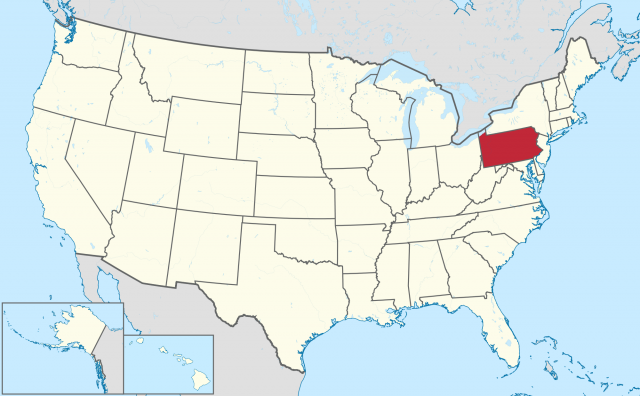Pennsylvania
THE COMMONWEALTH OF Pennsylvania, also known as the Keystone State, is located in the northeastern UNITED STATES. With a total area of 46,058 square mi (119,290 square km), Pennsylvania extends 307 mi (494 km) from east to west and 175 mi (282 km) north to south. It is bordered by NEW YORK and Lake ERIE to the north, WEST VIRGINIA and OHIO to the west, NEW JERSEY to the east, and MARYLAND, West Virginia, and DELAWARE to the south. The state, made up of 67 counties, is an industrial leader in the country and is famous for its many historical, cultural, and recreational sites, including Gettysburg, Amish Country, the Poconos, Independence Hall, Fallingwater, and Fort Necessity. As of 2003, Pennsylvania ranked sixth in the nation in population, with an estimated 12,365,500 residents. The most common ancestral heritages reported by Pennsylvanians are German, Irish, Italian, and English. Ten percent of the population is African American. Pennsylvania has a moderate climate with hot and humid summers and cold and snowy winters. Harrisburg is the state's capital.

Pennsylvania's diverse economy is dominated by the service sector, contributing 74 percent of the state's gross product. After the decline of the steel-making industry, the state had to adjust its manufacturing sector which now makes up 20 percent of the gross product. Food processing, chemical production, and electrical equipment dominate this part of the economy. Agriculture—dominated by livestock and dairy—and mining, mainly of petroleum, iron ore, natural gas, and coal, contribute 1 percent each toward Pennsylvania's gross product. One notable agricultural product activity is the harvesting of mushrooms in the southeast part of the state. Pennsylvania is the only producer of anthracite coal in the United States. However, the more common bituminous coal is also extracted.
In the early 1600s, Dutch sailors were the first Europeans to explore Pennsylvania. At the time of European arrival, native tribes in Pennsylvania included the Lenape, Susquehannock, Monongahela, Shawnee, Huron, and Erie. The first European settlement, south of present-day Philadelphia, however, was Swedish. While there were territorial disputes between the Swedes and the Dutch, England eventually took over the territory. King Charles II made a royal charter for Pennsylvania, or “Penn's Woods,” in 1681 and named the colony after Admiral Sir William Penn, the father of the founder of the state, William Penn. Penn, a member of the Society of Friends, or Quakers, became the caretaker of the new colony and wanted Pennsylvania to be a refuge for the persecuted Quakers in England. Penn set up Philadelphia as the first permanent English settlement in Pennsylvania.
Soon after this time, the French began to build forts in western Pennsylvania, but they were eventually all taken over by England. During the American revolutionary efforts against Great Britain, Philadelphia became the capital of the new country. Pennsylvania later became a state in 1787. The economy expanded in the 1800s with Pittsburgh and Philadelphia evolving into important shipping hubs. The first oil well in the world was drilled at Titusville in 1859 by Edwin Drake. Pennsylvania additionally benefited greatly from the Industrial Revolution and the two World Wars. With many coal sources within and near Pennsylvania, the commonwealth, especially the city of Pittsburgh, became the heart of the American steel industry, managed by entrepreneur Andrew Carnegie.
Pennsylvania's natural environment has changed drastically from the time of European arrival. The state has many old, winding rivers, and most of the state is hilly with plateaus, ridges, and valleys. Most of the lakes are man-made, and three-fifths of the state is covered by forests. Pennsylvania can be divided into seven main landform regions. Starting in the southeastern corner of the state, there is the Atlantic Coastal Plain, a small strip of low-lying and level ground that includes the state's largest city, Philadelphia. Immediately to the northwest is the Piedmont Plateau, an area of farmland, low hills, and rolling plains. This area covers most of southeastern Pennsylvania.
To the immediate northeast of the Piedmont, there is a narrow finger-shaped region extending out of New Jersey called the New England Upland. The industrial cities of Allentown, Bethlehem, and Easton are found in this area of low rolling hills and forests. At the southwestern part of the Piedmont, coming out of Maryland, is another narrow region called the Blue Ridge. The Blue Ridge province is hilly and has many productive farms, orchards, and dairies.
The Appalachian Ridge and Valley physiographic region is in the center of Pennsylvania and covers about half of the state, crossing from Maryland and into New Jersey. It is part of the Appalachian Mountains and includes the highest point in Pennsylvania, Mt. Davis at 3,212 ft (979 m). To the west and north is the Allegheny or Appalachian Plateau. This area consists of valleys and divides and covers the majority of western and northern Pennsylvania. Pittsburgh, the state's second largest city, is located here, as well as Allegheny National Forest. The region also once had very productive coal and natural gas mines.
Finally, on the northwest tip of the Pennsylvania panhandle is the Erie Lowland. Found on Lake Erie, the area is flat, has significant vegetable and fruit production, and also includes the city of Erie, a major shipping port for transport through the Great Lakes and the St. Lawrence Seaway.